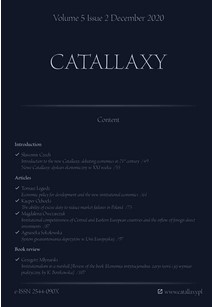Institutional competitiveness of Central and Eastern European countries and the inflow of foreign direct investments
Institutional competitiveness of Central and Eastern European countries and the inflow of foreign direct investments
Author(s): Magdalena OwczarczukSubject(s): National Economy, Business Economy / Management, Economic policy, International relations/trade, Comparative politics
Published by: Instytut Badań Gospodarczych
Keywords: FDI; competitiveness; institutions; GCI; institutional surrounding; CEE countries;
Summary/Abstract: Central and Eastern European countries (CEE) in spite of a long period of European Union membership and integration with the developed economies of Western Europe are still on the path of convergence, i.e. pursuing the highly developed countries in terms of, among others, GDP per capita. Assuming that the FDI inflow carries numerous benefits for the economic growth of the recipient country, those economies still compete against one another for foreign capital. One of the factors that attracts FDI is high quality of institutional surrounding. Aim: assessment of institutional competitiveness of the selected CEE countries (Czech Republic, Estonia, Lithuania, Latvia, Poland, Slovakia, Slovenia, Hungary) as well as verification of the relationship between institutional competitiveness and the FDI inflow to the analyzed economies. Materials and methods: The article reviews positions obtained by the selected CEE countries in the ranking of competitiveness published by Global Economic Forum (Global Competitiveness Report). The analysis and assessment of CEE countries competitiveness focused around the institutional quality assessment. Quantitatively, the connection was revealed between competitiveness ranking in the field of institutions and FDI inflow per capita and FDI as % of GDP to the economies under consideration. Results: the analysis of the global competitiveness index (GCI) allows to notice that among the CEE countries, Estonia is characterized with the highest institutional competitiveness. The detailed analysis indicated that low social capital quality decreases institutional competitiveness in case of all analyzed economies. The conducted quantitative analysis of the potential link between the GCI–Pillar 1. Institutions index and the inflow of foreign direct investments to CEE countries indicates the positive correlation of those variables. Higher index values (institution quality assessment) corresponds to the higher FDI per capita level and FDI calculated as GDP percentage.
Journal: Catallaxy
- Issue Year: 5/2020
- Issue No: 2
- Page Range: 87-96
- Page Count: 10
- Language: English

